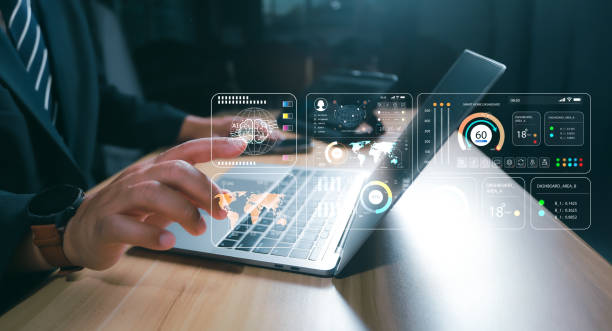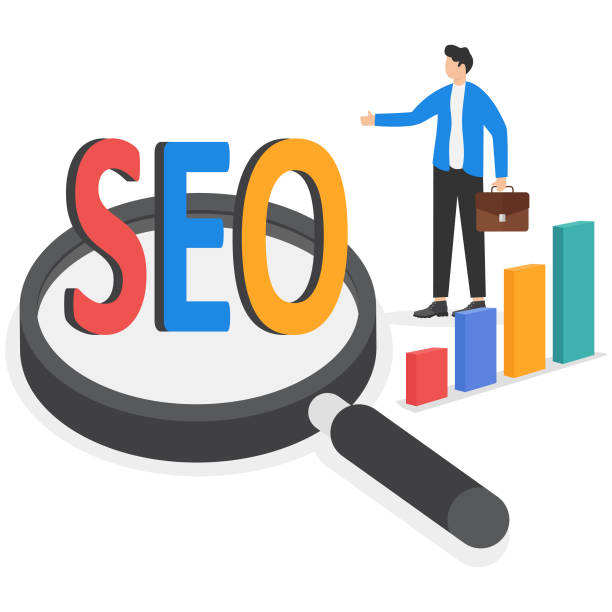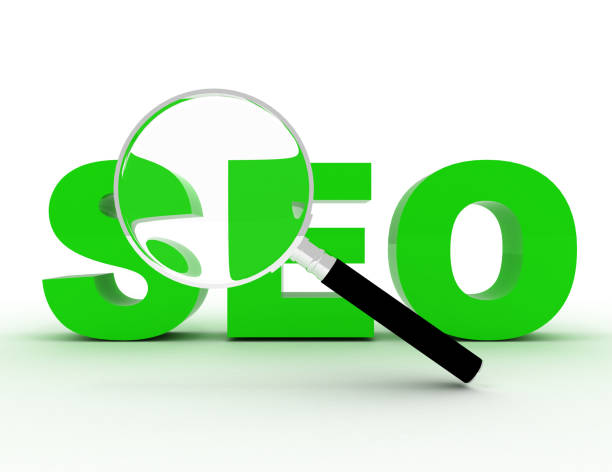What is On-Page SEO and why is it important?

What is On-Page SEO and why is it important?
On-Page SEO (#On-Page SEO) is a set of actions you take within your website to improve your site’s ranking in Google search results.
On-Page SEO includes optimizing content, site structure, title tags, meta descriptions, and other factors related to website content.
The importance of On-Page SEO is that it helps Google better understand your site’s content and show it to users looking for relevant information.
By optimizing #On_Page_SEO, you can attract more organic traffic to your site and, as a result, increase your conversion rate and revenue.
In fact, On-Page SEO is one of the main pillars of success in #Content_Marketing and gaining audience satisfaction.
To start On-Page SEO, you must first identify appropriate keywords and then optimize your content based on these keywords.
This means using keywords in titles, subheadings, main text, and image ALT tags.
Also, you should design your site’s structure in such a way that users can easily access the information they need.
Using appropriate internal links and creating a sitemap can help improve user experience and increase your site’s ranking in search results.
On-Page SEO and optimizing website pages helps you achieve a good position in Google results by using appropriate keywords and quality content.
Disappointed with your e-commerce site’s low conversion rate? Rasawb transforms your online store into a powerful tool for attracting and converting customers!
✅ Significant increase in visitor-to-buyer conversion rate
✅ Unparalleled user experience to boost customer satisfaction and loyalty⚡ Get free consultation from Rasawb!
Keyword Research and Choosing the Best for On-Page SEO

Keyword Research and Choosing the Best for On-Page SEO
Keyword Research is one of the most important steps in #On_Page_SEO.
To begin, you need to compile a list of keywords relevant to your business.
These keywords should be phrases that users employ when searching on Google.
To find these keywords, you can use various tools such as Google Keyword Planner, Ahrefs, SEMrush, and Keywordtool.io.
These tools help you discover search volume, competition level, and related keywords.
After compiling your keyword list, you should prioritize them based on their relevance to your business, search volume, and competition level.
Keywords with high search volume and low competition are the best options to start with.
Once you’ve selected appropriate keywords, you should use them strategically in your content.
This means incorporating keywords into titles, subheadings, the main text, image ALT tags, and meta descriptions.
However, you should avoid excessive use of keywords (Keyword Stuffing), as this can harm your site’s ranking.
Instead, try to write your content in a way that is natural and readable, and addresses user needs.
Finally, you should regularly review the performance of your keywords and update them as needed.
By consistently conducting keyword research, you can ensure that your content remains relevant and optimized.
To find the best keywords, you can use free and paid tools and analyze competitors to identify the best keywords.
Optimizing Title and Meta Descriptions to Attract Clicks

Optimizing Title and Meta Descriptions to Attract Clicks
The Title Tag and Meta Description are two important elements in On-Page SEO that are displayed in search results.
The title is the main title of your page and should contain the main keyword.
The meta description is a short summary of your page’s content and should encourage users to click.
To optimize the title, you should use an attractive and relevant title that contains the main keyword.
The title length should not exceed 60 characters, as Google usually truncates longer titles.
To optimize the meta description, you should use an attractive and informative summary that encourages users to click.
The meta description length should not exceed 160 characters.
Also, you should use relevant keywords in the meta description.
Titles and meta descriptions should be unique for each page, and you should not use duplicate content.
By optimizing your titles and meta descriptions, you can increase your Click-Through Rate (CTR) and attract more traffic to your site.
Additionally, you should regularly review the performance of your titles and meta descriptions and update them as needed.
By doing this, you can ensure that your titles and meta descriptions are always attractive and relevant.
Meta descriptions and page titles should be attractive and relevant to the page content to encourage users to click.
| Element | Description | Best Practice |
|---|---|---|
| Title Tag | The main title of the page displayed in search results. | Contains the main keyword, attractive and relevant to the content, maximum 60 characters. |
| Meta Description | A short summary of the page’s content displayed in search results. | Attractive and informative, encouraging clicks, maximum 160 characters, contains relevant keywords. |
Content Optimization and Natural Keyword Usage

Content Optimization and Natural Keyword Usage
Content is King! This phrase is widely heard in the world of SEO and indicates the high importance of content in ranking your site in search results.
To optimize content, you must produce high-quality, relevant, and valuable content that addresses user needs.
Your content must be unique and original, and you should not use duplicate content.
Also, you should write your content in a way that is readable and engaging, encouraging users to stay on your site.
To use keywords in content, you should use them naturally within the main text.
Avoid excessive use of keywords, as this can harm your site’s ranking.
Instead, try to write your content so that keywords naturally fit in and contribute to the readability of the text.
Additionally, you should use related keywords (LSI Keywords) in your content.
These keywords help Google better understand the topic of your page and show it to users looking for relevant information.
Finally, you should regularly update your content and ensure it is always relevant and accurate.
By producing quality content and optimizing it for keywords, you can improve your site’s ranking in search results and attract more traffic to your site.
Using proper On-Page SEO helps your business.
To produce quality content, you need to understand your users’ needs and create content that answers their questions.
Are you worried that your company’s old website is driving new customers away? Rasawb solves this problem with modern and efficient corporate website design.
✅ Increases your brand’s credibility.
✅ Helps attract targeted customers.
⚡ Contact Rasawb for a free consultation!
Image Optimization and ALT Tag Usage

Image Optimization and ALT Tag Usage
Images play an important role in your website’s user experience.
Attractive and relevant images can capture users’ attention and encourage them to stay on your site.
But images can also help with your On-Page SEO.
To optimize images, you should use high-quality images with a small file size.
Large images can slow down your page loading speed, which can harm your site’s ranking.
To reduce image file sizes, you can use image compression tools.
Also, you should use relevant and descriptive file names for your images.
Instead of using default file names like IMG_1234.jpg, use file names like seo-dakheli.jpg.
The most important aspect of image optimization is using the ALT tag.
The ALT tag is an alternative text for the image that is displayed if the image cannot be shown.
The ALT tag should be descriptive and relevant to the image, and contain the main keyword.
By using the ALT tag, you can help Google better understand your image and show it to users looking for relevant images.
Finally, you should ensure that your images are displayed correctly on the page and have appropriate dimensions.
By optimizing images, you can improve your website’s user experience and increase your site’s ranking in search results.
Don’t forget your website’s On-Page SEO.
Website image optimization includes choosing the right format, reducing file size, and using appropriate alt tags.
Optimizing URL Structure and Internal Links

Optimizing URL Structure and Internal Links
URL structure and internal links are two important factors in On-Page SEO that can help improve your site’s ranking in search results.
The URL structure should be simple, descriptive, and contain the main keyword.
Avoid using long and complex URLs.
Instead of URLs like example.com/page?id=123, use URLs like example.com/seo-dakheli.
Internal links are links that go from one page on your site to another page on your site.
Internal links can help improve user experience and increase your site’s ranking.
By creating relevant and appropriate internal links, you can help users easily access the information they need.
Also, you can help Google better understand your site’s structure and identify more important pages.
When creating internal links, you should use appropriate Anchor Text.
The anchor text should be descriptive and relevant to the destination page and contain the main keyword.
Avoid using generic anchor texts like “click here”.
Finally, you should ensure that your internal links work correctly and that there are no broken links.
By optimizing URL structure and internal links, you can improve your website’s user experience and increase your site’s ranking in search results.
Improving On-Page SEO leads to an increase in site ranking on Google.
An appropriate URL structure should be short, relevant, and include the main keyword.
Website Loading Speed Optimization

Website Loading Speed Optimization
Website loading speed is one of the important factors in your site’s ranking in search results.
Google gives higher rankings to sites that load faster.
Also, users prefer to visit sites that load more quickly.
To optimize website loading speed, you can use various methods.
These methods include: compressing images, enabling caching, using a CDN (Content Delivery Network), reducing the size of HTML, CSS, and JavaScript codes, and choosing a suitable hosting provider.
By compressing images, you can reduce their file size and increase your page loading speed.
By enabling caching, you can store your site’s static files in users’ browsers, increasing page loading speed on subsequent visits.
By using a CDN, you can store your site’s files on various servers worldwide and provide users with the closest server.
By reducing the size of HTML, CSS, and JavaScript codes, you can decrease your page size and increase page loading speed.
By choosing a suitable hosting provider, you can ensure that your site is hosted on a high-speed and reliable server.
Finally, you should regularly check your site’s loading speed and take necessary actions if needed.
By optimizing website loading speed, you can improve your website’s user experience and increase your site’s ranking in search results.
Professional On-Page SEO helps you increase site speed.
Website loading speed is one of the most important factors in user experience and site ranking on Google.
| Optimization Method | Description | Benefits |
|---|---|---|
| Image Compression | Reduces image size without losing quality. | Increases page loading speed, reduces bandwidth consumption. |
| Cache Activation | Stores static files in the user’s browser. | Increases loading speed on subsequent visits. |
| Using CDN | Stores website files on various servers worldwide. | Delivers content from the closest server to the user, increases loading speed. |
Mobile Optimization (Mobile-Friendly)

Mobile Optimization (Mobile-Friendly)
Given the increased use of mobile devices for internet searches, optimizing your site for mobile (Mobile-Friendly) is crucial.
Google gives higher rankings to mobile-optimized sites.
Users also prefer to visit sites that display correctly on mobile.
You can use various methods to optimize your site for mobile.
These methods include: using Responsive Design, using readable fonts, using large buttons, reducing image sizes, and using mobile-optimized videos.
By using responsive design, you can design your site to automatically adapt to the screen size of the user’s device.
By using readable fonts, you can ensure that your site’s text is easily legible on mobile.
By using large buttons, you can help users easily click on them.
By reducing image sizes, you can increase your page loading speed on mobile.
By using mobile-optimized videos, you can ensure that your site’s videos play correctly on mobile.
Finally, you should regularly test your site on mobile and take necessary actions if needed.
By optimizing your site for mobile, you can improve your website’s user experience and increase your site’s ranking in search results.
On-page SEO for mobile sites should be considered.
Optimizing a website for mobile includes using responsive design, readable fonts, and high loading speed.
Does your current e-commerce website design not generate the expected sales?
Rasawb specializes in professional e-commerce website design!
✅ An attractive and user-friendly website aimed at increasing sales
✅ High speed and security for an ideal shopping experience⚡ Get a free online store design consultation with Rasawb!
Using Schema Markup

Using Schema Markup
Schema Markup is a code you can add to your site’s HTML to help Google better understand your page content.
Schema Markup can provide information such as your business name, address, phone number, operating hours, ratings, and other relevant details to Google.
By using Schema Markup, you can enrich your search results and display more information to users.
Richer search results can increase your Click-Through Rate (CTR) and attract more traffic to your site.
To use Schema Markup, you can use various tools such as Google Structured Data Markup Helper.
This tool helps you create the appropriate Schema Markup code for your page.
After creating the Schema Markup code, you must add it to your site’s HTML.
To ensure your Schema Markup code is working correctly, you can use the Google Rich Results Test tool.
This tool shows you how your page will appear in search results.
Finally, you should regularly review your Schema Markup code and update it as needed.
By using Schema Markup, you can help Google better understand your page content and increase your site’s ranking in search results.
On-page SEO with Schema is very important.
Schema Markup helps Google better understand your page content and improves your site’s display in search results.
Analyzing and Continuously Improving On-Page SEO

Analyzing and Continuously Improving On-Page SEO
On-Page SEO is an ongoing process and should not be done once and forgotten.
To continuously improve On-Page SEO, you should regularly analyze your site’s performance and take necessary actions if needed.
To analyze site performance, you can use various tools such as Google Analytics and Google Search Console.
Google Analytics helps you analyze your site traffic and obtain information such as the number of visitors, average time spent on the site, and bounce rate.
Google Search Console helps you analyze your site’s performance in search results and obtain information such as site ranking, number of clicks, and impressions.
By using these tools, you can identify the strengths and weaknesses of your site’s On-Page SEO and take necessary actions to improve it.
For example, if you notice that your site’s bounce rate is high, you should improve your content and ensure that users can easily access the information they need.
If you notice that your site’s ranking for certain keywords is low, you should optimize your content for those keywords.
Finally, you should regularly track your On-Page SEO changes and evaluate their impact on your site’s ranking and traffic.
By analyzing and continuously improving On-Page SEO, you can increase your site’s ranking in search results and attract more traffic to your site.
On-Page SEO and its continuous analysis have a significant impact on your website’s growth.
Continuous analysis and improvement of On-Page SEO helps you stay informed about the latest Google algorithm changes and update your strategies.
Frequently Asked Questions
| Row | Question | Answer |
|---|---|---|
| 1 | What is On-Page SEO? | On-Page SEO refers to a set of actions taken within a website (on its pages) to improve its ranking in search engine results. This includes optimizing content, site structure, and HTML codes. |
| 2 | Why is On-Page SEO important? | On-Page SEO helps search engines better understand page content and determine if that page is relevant and valuable for user queries. This better understanding leads to higher rankings. |
| 3 | What is the first and most important step in On-Page SEO? | Keyword Research is the most important initial step. By finding appropriate keywords, targeted content relevant to user needs can be produced. |
| 4 | What is the role of the Title Tag in On-Page SEO? | The title tag is one of the most important ranking factors and should include the main keyword. This tag is displayed as the page title in search results and influences the Click-Through Rate (CTR). |
| 5 | What is the importance of Meta Description? | The meta description does not directly affect rankings, but by providing an attractive summary of the page’s content in search results, it can encourage users to click, thereby increasing the Click-Through Rate (CTR). |
| 6 | Why is using headings (H1, H2, etc.) important in content? | Headings help structure content and improve readability for both users and search engine crawlers. Using keywords in headings also helps search engines better understand the topic. |
| 7 | What does Image Optimization in On-Page SEO include? | It includes compressing images to reduce size, using descriptive and relevant file names, and filling the Alt tag (alternative text) with relevant keywords to help search engines understand the image content. |
| 8 | What is Internal Linking in On-Page SEO? | Internal linking refers to creating links between different pages of a website. This helps distribute page authority (Link Equity), improves user experience, and assists search engine crawlers in discovering new pages. |
| 9 | Why is Page Speed important for On-Page SEO? | Page loading speed is a direct ranking factor and significantly impacts user experience. Slow pages can lead to an increased Bounce Rate and reduced user engagement. |
| 10 | What role does quality content play in On-Page SEO? | High-quality, comprehensive, unique, and valuable content for the user, is the core of On-Page SEO. This content not only attracts and retains users but also sends positive signals to search engines, helping achieve better rankings. |
And other services of Rasawb Advertising Agency in the field of advertising
- Smart Digital Branding: A combination of creativity and technology to improve SEO ranking through attractive UI design.
- Smart Brand Identity: A specialized service for growth in sales based on attractive UI design.
- Smart Conversion Rate Optimization: Transform user engagement by optimizing key pages.
- Smart Google Ads: A fast and efficient solution for user engagement with a focus on custom programming.
- Smart Advertising Campaigns: A fast and efficient solution for user engagement with a focus on smart data analysis.
And over hundreds of other services in the field of internet advertising, advertising consulting, and organizational solutions
Internet Advertising | Advertising Strategy | Advertorials
Resources
What is On-Page SEO?
What is On-Page SEO and How to Do It?
On-Page SEO Tutorial + On-Page SEO Checklist
What is Website On-Page SEO? The Most Important On-Page SEO Factors
? To boost your business in the digital world, count on the expertise of “Rasawb Afarin”! We help you establish a powerful and influential online presence by providing comprehensive digital marketing services, including multilingual website design.
📍 Tehran, Mirdamad Street, next to Bank Markazi, Southern Kazeroun Alley, Ramin Alley, No. 6

